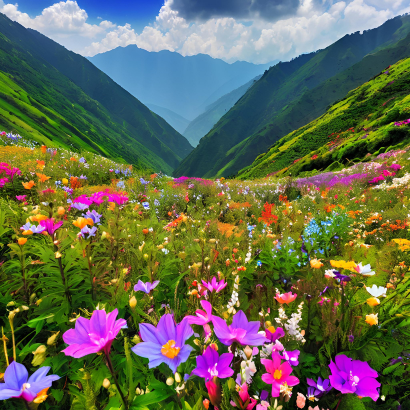Nestled in the heart of the Himalayas, the Valley of Flowers National Park is a paradise for nature enthusiasts and adventurers alike. This UNESCO World Heritage Site, located in Uttarakhand, India, is renowned for its vibrant and diverse array of flora, stunning landscapes, and unique biodiversity.
Introduction
Nestled in the heart of the Himalayas, the Valley of Flowers National Park is a paradise for nature enthusiasts and adventurers alike. This UNESCO World Heritage Site, located in Uttarakhand, India, is renowned for its vibrant and diverse array of flora, stunning landscapes, and unique biodiversity. Whether you’re a seasoned trekker or a casual nature lover, the Valley of Flowers promises an unforgettable experience that celebrates the splendor of nature.
The Magic of the Valley
A Natural Wonderland
Spanning approximately 87.5 square kilometers, the Valley of Flowers is a pristine sanctuary characterized by its lush meadows adorned with a myriad of wildflowers. The valley lies at an altitude of 3,500 to 3,800 meters above sea level and is part of the Nanda Devi Biosphere Reserve. It was discovered in 1931 by a team of British mountaineers and has since captivated the hearts of many with its breathtaking beauty.
Flora and Fauna
The valley’s diverse ecosystem supports over 500 species of wildflowers, including the iconic blue poppy, the delicate primula, and the vibrant marigold. Each flower blooms at different times, creating a constantly changing tapestry of colors. The region is also home to several species of rare animals such as the Himalayan black bear, the snow leopard, and the endangered Himalayan musk deer.
Planning Your Visit
Best Time to Visit
The ideal time to visit the Valley of Flowers is between mid-July and early September when the flowers are in full bloom. During this period, the weather is relatively mild and pleasant, making it perfect for trekking and sightseeing. However, the valley is closed from October to June due to heavy snowfall and extreme cold.
Getting There
The journey to the Valley of Flowers typically begins from Rishikesh or Haridwar, from where you can drive to the town of Joshimath. From Joshimath, you’ll need to take a shared taxi or jeep to Govindghat, the base camp for the trek. The trek to the Valley of Flowers begins from Ghangaria, a small village accessible by a 13-kilometer trek or by pony ride from Govindghat.
Trekking the Valley
The Trek Route
The trek to the Valley of Flowers is relatively moderate, with a well-marked trail that passes through dense forests, gushing rivers, and picturesque meadows. The route is approximately 17 kilometers one way from Ghangaria to the valley. The trail offers stunning views of the surrounding mountains and provides plenty of opportunities for photography.
Essential Tips for Trekkers
- Physical Preparation: Although the trek is not extremely challenging, a moderate level of fitness is recommended. Prepare by doing some pre-trek hikes or cardio exercises.
- Gear and Packing: Bring comfortable trekking shoes, warm clothing (even in summer), rain gear, and sufficient water. Also, carry a sturdy backpack with essentials like snacks, a first-aid kit, and a camera.
- Permits: You’ll need to obtain permits for the national park, which can be acquired at the entry point in Ghangaria.
Accommodation and Food
Staying in Ghangaria
Ghangaria, the last human settlement before the Valley of Flowers, offers a range of accommodation options, from basic guesthouses to more comfortable lodges. It is advisable to book your stay in advance, especially during peak season. The village also has several small eateries where you can enjoy local cuisine and basic meals.
Cultural and Spiritual Significance
Local Traditions
The Valley of Flowers holds significant cultural and spiritual importance for the local communities, particularly the Nanda Devi and the Bhotiya tribes. The valley is considered sacred, and local festivals and rituals are often held to honor the deities and nature.
Conservation Efforts
Protecting the Ecosystem
The Valley of Flowers National Park is not just a haven for flora and fauna but also a crucial part of the Himalayan ecosystem. Conservation efforts are in place to protect this delicate environment from the impacts of tourism and climate change. The park authorities work tirelessly to maintain the ecological balance and educate visitors on the importance of preserving natural habitats.
How You Can Contribute
Visitors can contribute to conservation efforts by following park regulations, avoiding the picking of flowers, and minimizing their impact on the environment. Participating in guided eco-tours and supporting local conservation initiatives also help in preserving the beauty and biodiversity of the valley.
Personal Reflections
The Enchantment of the Valley
A visit to the Valley of Flowers is more than just a trek; it’s an immersion into a magical realm where every step reveals nature’s artistry. The tranquility of the valley, combined with the vibrant colors and fresh mountain air, creates an experience that is both exhilarating and serene. For many, the journey to this natural wonder becomes a cherished memory and a reminder of the beauty and fragility of our planet.
Conclusion
The Valley of Flowers National Park is a testament to the incredible beauty and diversity of the natural world. From its colorful meadows to its majestic mountains, this unique destination offers a rare glimpse into nature’s grand design. Whether you’re exploring its trails, marveling at its flora, or reflecting on its cultural significance, the Valley of Flowers is a place that inspires awe and reverence.
So pack your bags, lace up your hiking boots, and embark on a journey to one of nature’s most enchanting wonders. The Valley of Flowers awaits, ready to share its breathtaking beauty with those who seek its splendor.



